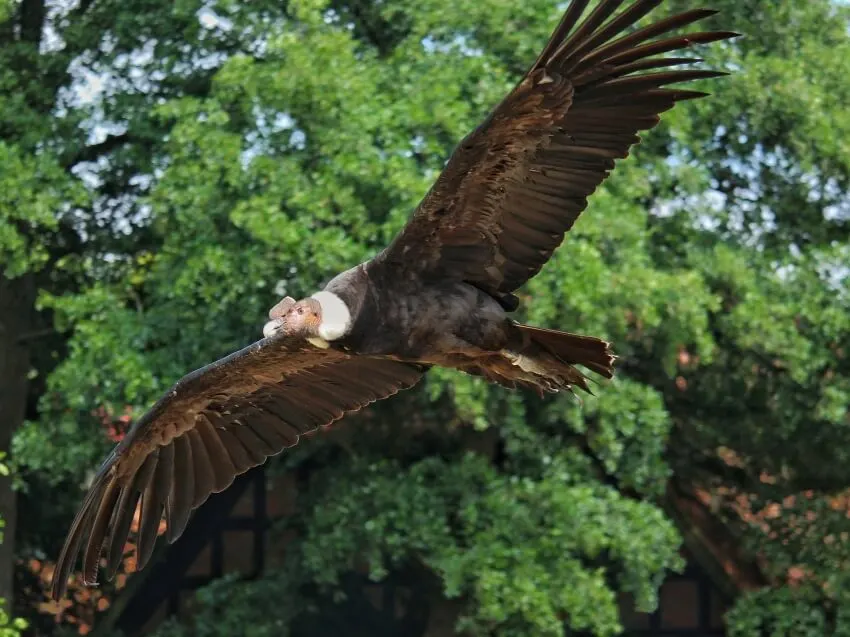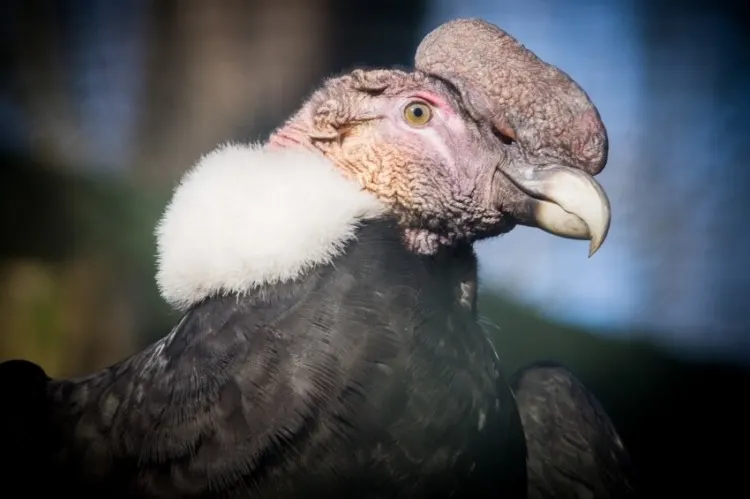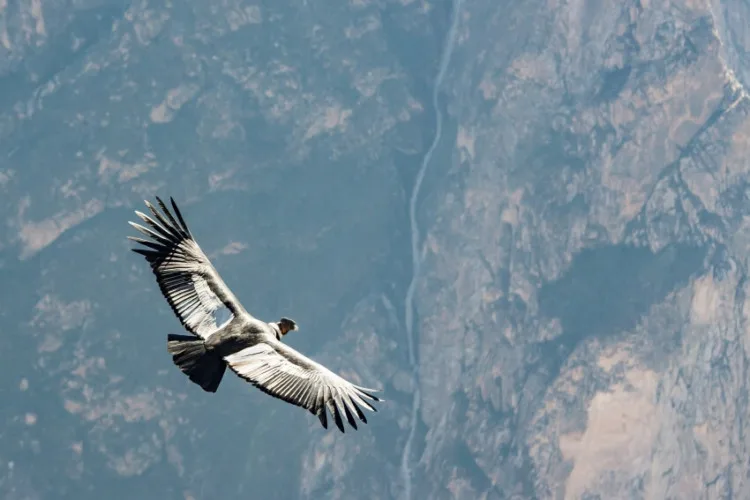Andean Condors are Andean Birds with a wingspan of up to 10 feet. It is a bird species that can be found in the Andes Mountains in South America, and its diet consists mainly of carrion, which may include dead animals from the Andean mountains.
- Status: Near threatened
- Known as: Andean Condor
- Estimated numbers left in the wild: Several thousand; no accurate figures are available.

Andean Condors are not endangered but they are considered vulnerable to extinction because their population has decreased due to hunting and pesticides that have killed off much of their food supply. These species can live up to 30 years in captivity or 50-70 years in the wild.
It is also a national symbol in various countries such as Bolivia, Argentina, and Colombia. Also in Peru, Ecuador, and Chile.
Description
The Andean condor is classified as a raptor, a bird of prey, and the largest flying bird of this type. It is a bird species that is related to California condors.
Anatomy and Appearance
The physical characteristics of this huge and heavy bird are it has a wingspan up to 320 centimeters and a beak to a tail length between 100 centimeters and 130 centimeters. These birds can weigh 15 kilograms.
Not only are the male birds larger than the females, but their wattles and comb also distinguish them.
Both sexes sport a fluffy white-collar, while the predominant body color is black with white secondary wing feathers. This condor has a long lifespan, 50 years or more.
Location
The Andean condor is found all along the western coast of South America, especially in Tierra del Fuego and Chile along the ridge of the Andes Mountains, although it is rare in the northern section of its range. Although mountains are its favorite locale, it is sometimes found in deserts, grasslands, or along the shore.
Andean Condor Habitat
Andean Condors are found in the Andes mountains in South America.
They live in high Andean peaks and can be found up to elevations of 18,000 feet. They prefer to live in open areas with rocky cliffs for nesting and roosting.
It is a bird species that are not considered endangered, but they are vulnerable to extinction because their population has decreased. The average life expectancy of an Andean condor in captivity is 30 years, while that of one in the wild is 50-70 years.
Andean Condor Diet and Nutrition
Andean condors are scavengers, meaning that they feed mostly on dead animals, although they have been known to take sea birds and eggs. However, their beaks are not as strong as those of eagles and hawks but are suited to tearing open carcasses.
The lack of feathers on the head is an adaptation that keeps the bird cleaner when eating, and their digestive system has evolved to handle bacteria so that the condor will not become ill from eating rotten meat.
Because the condor locates carcasses by sight rather than by smell, it tends to avoid forested or brushy areas where spotting dead animals could be difficult or impossible.
Areas such as these might also present problems with the bird getting airborne again too. The Andean condor will sometimes fly 120 kilometers a day in search of food.
Andean Condor Mating Habits
The female and male Andean condor mates for life and nests at high elevations. These species also display sexual dimorphism. It is thought that because of the heavyweight of the bird, it needs the altitude and strong air currents found in mountainous regions and terrains to get off the ground easily.
The female lays one egg every other year right on the bare rock ledge, and both parents participate in incubation and care of the chick. The chicks cannot fly until they are 6 months old and remain under their parent’s care for two years.
See Related: Endangered vs. Threatened v.s Extinct
Andean Condor vs Vultures
The Andean Condor is a bird found in the Andes Mountains.
They are scavengers and their diet consists mainly of carrion, which may include dead animals from the Andean mountains.
Vultures, on the other hand, are birds that feed primarily on carrion. There are several different species of vultures and other raptors, the most common of which is the Turkey Vulture.
These condors are very similar to vultures in that they are both scavengers, but they are much larger than vultures. Andean Condors have been listed as vulnerable to extinction by the IUCN, while vultures have not been listed as threatened at all.
Andean Condor and Human Relationship
Andean Condors and Humans have a complex relationship.
These bird species are not endangered but they are considered vulnerable to extinction because their population has decreased due to hunting and pesticides that have killed off much of their food supply on their habitat.
The maximum lifespan of these bird species in captivity is 30 years, although they may live up to 70 years in the wild. Condors have been used as a “tradition hunt” by the Andean people for centuries, Andean condor hunts have been going on since before the 1940s.
These large birds also provide a vital service by disposing of dead animals from the Andes mountains which is an important environmental service. They have been able to adapt to some changes, but there is still a lot of hunting pressure on Andean Condors and they are still vulnerable to extinction.
Andean Condor Role in the Ecosystem
Andean Condors play an important role in the Andean ecosystem by helping to keep the population of carrion under control.
They are also an important part of the tourism industry in Western South America, as people often visit the Andes Mountains to see these large birds.
These bird species are also a source of food for other animals in the Andes Mountains, and they help to spread seeds from the plants that they eat.
Despite their significance, these condor is threatened by human activities such as hunting and pesticides that have destroyed much of its food supply, causing its population to plummet.
Cultural Siginficance of Andean Condor
The huge bird has great significance to many Andean cultures. In Andean mythology, Andean Condors are believed to be the souls of people who have been turned into these birds. It is also a creature that is treated with much respect and folklore and Andean art because Andean comes alive at dusk and is connected to the upper world.
Andean Condor Facts
Here are interesting facts about Andean Condor.
- Andean Condors are the heaviest flying bird in the world.
- They have a wingspan of up to 10 feet, which is equivalent to approximately 3 times their body length.
- These condors are not endangered but they are considered vulnerable to extinction because their population has decreased due to hunting and pesticides that have killed off much of their food supply.
- It is bird species that can live up to 30 years in captivity or up to 70 years in the wild.
- These condors are found throughout the Southern part of America, mainly inhabiting the Andes mountains.
- They eat mainly carrion, which is any dead animal from Andes Mountains.
- They are not endangered but they are considered vulnerable to extinction because their population has decreased due to hunting and pesticides that have killed off much of their food supply.
See Related: Philippine Eagle
Conservation Status

The Andean Condor is considered a vulnerable species due to its declining population.
Threats
Humans have moved into some of the areas formerly used by the condors, and it is now very rare in Colombia and Venezuela. The condor is sometimes killed by farmers who believe that it is attacking their livestock.
Another threat comes from the primitive belief that different body parts of the condor will treat certain ailments – it is thought that cancer can be cured by eating the condor’s stomach and getting sharper eyesight by eating the eyes.
The poisons used in killing predatory animals are sometimes ingested by the condor, and pesticide residues could be affecting fertility and overall health.
Conservation efforts
Although numbers of the condor had dipped perilously, efforts to save this species have been successful so far. With a release in the birds’ home range, Northern and Southern American captive breeding has the condor soars to climb. The hand-reared, released birds have bred in the wild.
Organizations
Do you know of or are you a part of an organization that works to conserve wildlife especially the Andean Condor? Then please contact us to have it featured on Our Endangered World.
How to Help
Andean Condor conservation efforts can help prevent condors from becoming endangered. Such efforts might include keeping Andean condor populations healthy, monitoring Andean condor populations, and limiting the use of pesticides in Andean condor habitat areas.
Andean Condor populations have decreased in the past, but they are slowly increasing thanks to these conservation efforts. These condors are an important part of Andean ecosystems and their loss would be tragic.
See Related: Best Conservation Posters
Final Thoughts
Andean Condors are not endangered but they are considered vulnerable to extinction because their population has decreased due to hunting and pesticides that have killed off much of their food supply.
They can live up to 30 years in captivity or 50-70 years in the wild, which is a testament to how hardy these Andes Mountains dwellers really are.
These huge creatures’ mating habits include monogamy for life and nesting at high elevations-perhaps this is why Andeans don’t seem as threatened by Andean condors as other birds might be?
The condor’s biggest threats come from humans who move into territories formerly used by the bird, those who kill them out of fear or anger, those who believe eating Andean condor parts is medicine and pesticides.
These bird species are not endangered but they are considered vulnerable to extinction because their population has decreased due to hunting and pesticides that have killed off much of their food supply.
FAQ

What is Andean Condor?
Andean Condor is a large Andean bird with a wingspan of up to 10 feet.
They are can be found in the Andes Mountains in Southern America, and their diet consists mainly of carrion, which may include dead animals from the Andean mountains.
It is a species that is not endangered but they are considered vulnerable to extinction because its population has decreased due to hunting and pesticides that have killed off much of their food supply.
Is the Andean condor extinct?
Andean condors are not extinct and endangered, but they are considered vulnerable to extinction.
But their population is decreasing because of hunting and pesticides that have left little carrion for them to eat. Condors do not mate often or usually produce many chicks.
What do Andean condors eat?
Andean Condors typically feed on small mammals, reptiles, eggs, dead animals from the Andes Mountains, and some plants.
How long does Andean Condor live in the wild and captivity?
Andean Condor is a large Andean bird that can live up to 30 years in captivity or 50-70 years in the wild.
Are Andeans threatened by Andean Condors?
Andean is not threatened by condors because Andeans live in the Andes Mountains, thus creating a large distance from Andean Condors.
There’s ample terrain to make it difficult for Andeans and condors to come into contact with each other.
Additionally, because their diet consists mainly of carrion, which may include dead animals from the Andean mountains, their food supplies are different and therefore they don’t interfere with each other’s territory.
Does Andean Condor eat other animals than carrion like birds and humans?
These condors can eat any type of meat including mammals, birds, reptiles, amphibians, and fish – it may even hunt prey species as large as deer if they don’t have access to carrion.
These condors are opportunistic feeders, meaning they will eat what is readily available rather than store food for later consumption.
They have also been known to steal meat from humans that are hunting or camping, which is how Andean Condors often end up becoming ‘endangered’.
Condors eat Andean mountains carrion, specifically dead Andean mountain creatures, but these condor does not usually find humans on the Andes mountains.
Andeans keep to themselves and don’t sometimes share homes with Andeans, so it is not common for them to kill or eat other human beings.
How many Andean condors are left in the world?
It is difficult to say with certainty, as condor populations near the Andes Mountains in South America were not reliably surveyed until 1985.
Older estimates given from 1980-2002 ranged from 20,000-25,000 individuals. Now they estimate about 10 young birds a year enter condor breeding age groups which are significantly less than before 2002 due to habitat destruction and competition for carrion food supply.
Is Andean Condor a New World Vulture?
Andean condors (new world vultures) are immediately distinguishable from condors by the distinct red/pink bald heads and throat that they exhibit when exposed to sunlight than other vultures. Adult Andean condors then darken to black with white patches on the underside of their wings reminiscent of an American Bald Eagle.
Other Species Profile
Related Resources
